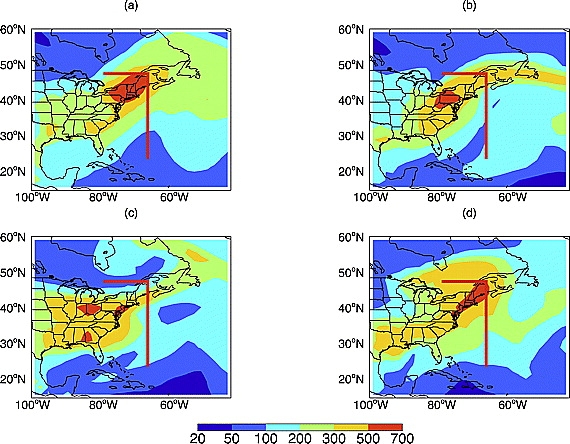Featured Results
Study by Fang, Y., A. M. Fiore, L. W. Horowitz, A. Gnanadesikan, H. Levy, Y. Hu, and A. G. Russell

Figure. NAFF CO tropospheric column (unit: 1015 molecules cmâ??2)
over the eastern United States from the INTEX-NA simulation on (a) July
16, (b) July 19, (c) August 4, and (d) August 11. Black lines show the
northeast boundary of the United States used to estimate export fluxes.
Previous
episodic export studies focused on plumes observed downwind of the
source region during cyclone passages. To date, no clear relation was
provided between strong export events and cyclone passages. In our
study, we apply a purely statistical method to CO daily fluxes from
the United States simulated by Mozart-2 to identify strong export
events and investigate the meteorology associated with these events.
Our study successfully shows that strong export days are
preferentially associated with migratory mid-latitude cyclones,
supporting the previous hypothesis that strong export events
are caused by passages of cyclones. Moreover, we also find that
export during days without cyclone passages makes a major
contribution to the total export and thereby to the global pollutant
budget (see Figure below). Therefore, focusing exclusively on outflow
plumes during cyclone passages, although critical for understanding
the transport processes of pollutants from the source region,
provides an incomplete picture of total U.S. pollutant export. An
emphasis in future campaigns on
other mechanisms (westward extension of Bermuda high and convection,
particularly in the southeastern United States) would provide
additional insights and key tests for models. For detailed
description and evaluation of this study, please refer to Fang, Y.,
A. M. Fiore, L. W. Horowitz, A. Gnanadesikan, H. Levy, Y. Hu, and A.
G. Russell (2009), Estimating the contribution of strong daily
export events to total pollutant export from the United States in
summer, J. Geophys. Res., doi: 10.1029/2008JD010946, in press.


